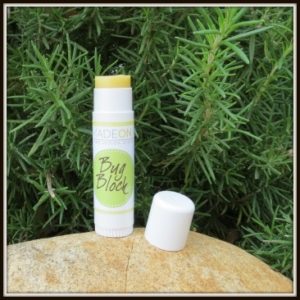 6/30/2016 To comply with the labeling and ingredient requirements by the U.S. EPA (Environmental Protection Agency) we’ve updated information on our Bug Block labels and made one ingredient switch in the recipe. The original recipe was fine by safety standards (per essential oil safety expert Robert Tisserand) and was officially checked by someone who is an authority on EPA requirements to be able to use as a repellent, but with along with one ingredient switch, the label itself needed to also include some information that was not included on the original label.
6/30/2016 To comply with the labeling and ingredient requirements by the U.S. EPA (Environmental Protection Agency) we’ve updated information on our Bug Block labels and made one ingredient switch in the recipe. The original recipe was fine by safety standards (per essential oil safety expert Robert Tisserand) and was officially checked by someone who is an authority on EPA requirements to be able to use as a repellent, but with along with one ingredient switch, the label itself needed to also include some information that was not included on the original label.
CHANGES
- The active ingredients used to repel bugs must be spelled out as such (must have the word “active ingredient” on it). We are separating the listing of active ingredients (the essential oils and their percentages) from the inactive ingredients (shea butter, coconut oil, beeswax)
- We cannot have lavender as an ingredient in a bug repellent per the EPA. (I have wrestled with this one, because commonly consumed ingredients are fine and as lavender is also a consumable ingredient, I’ve ignored it. But upon closer investigation, this wouldn’t qualify as an acceptable bug block ingredient unless I officially pay to run the recipe past the EPA.) Rosemary oil is on the acceptable bug repellent ingredient list, so we’ve replaced lavender with rosemary.
- Per California law, and because we are a California based company, citronella can only make up 1% of the formula, and our recipe called for 2.5%, so I’m reducing the amount of citronella to comply with the 1% maximum allowed. I’m increasing the amount of cedar and rosemary to replace the loss. If we operated out of a different state, this would not be an issue. (For those who DIY, go ahead and continue with the 2.5% that my recipes offer… this is only for California companies who sell bug repellent.)
- Also per California law, any bug repellent topical product must also have a Caution statement for children. (Don’t worry – it’s safe for children… we wouldn’t need to include this if we didn’t live in CA.)
- The only adjustment to the recipe is that the rosemary replaces lavender, and the citronella is reduced but replaced by more cedar and rosemary to make up the 7.5% of the recipe, just like before.
Bug Block Ingredients
7.5% active ingredients (INCI): pure essential oils of juniperus virginiana (cedarwood) oil 3.25%, rosmarinus officinalis (rosemary) oil 3.25%, cymbopogon nardus (citronella) oil 1%
92.5% inactive ingredients (INCI): beeswax, cocos nucifera (coconut) oil, butyrospermum parkii (shea butter)
Apply liberally as needed.
Other questions you might have:
- Is the new recipe as effective as the original? Yes, based on customer feedback. We’re still using bug-repelling ingredients, in the same overall proportions.
- Does it smell differently? Yes, I notice the cedarwood more in this one, so think woodsy more than a citronella-citrusy scent.
- Are you moving out of California since the laws are so strict there? Nope. I love my state.
